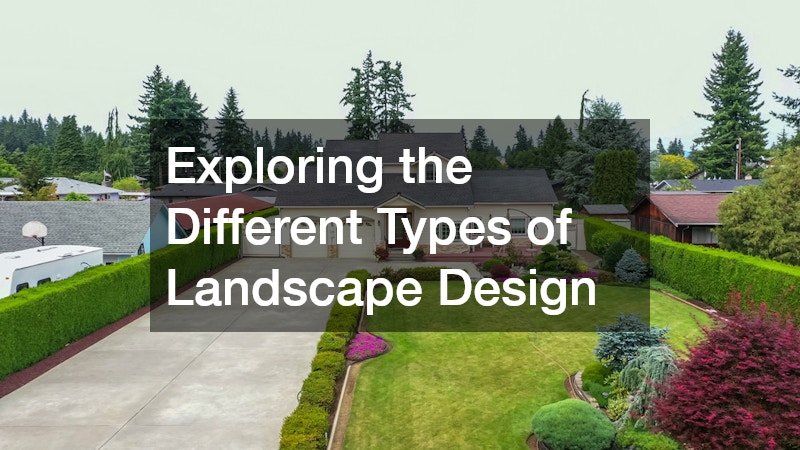Landscape design is more than just planting flowers or mowing the lawn—it’s a comprehensive process that involves shaping outdoor spaces to reflect functionality, aesthetic appeal, and ecological balance. Whether you’re a homeowner seeking to enhance curb appeal or a business investing in a welcoming exterior, landscape design offers an array of possibilities. Understanding the different types of landscape design is key to creating outdoor environments that meet your goals and complement your surroundings. From hardscaping to choosing the right plants and hiring the right professionals, every detail matters.
What Are the Main Types of Landscaping?

Residential Landscaping
Residential landscaping focuses on beautifying the outdoor spaces around private homes. This type of design considers family needs, recreational areas, and aesthetic preferences. It often includes lawn care, flower beds, patio pavers, and backyard hardscaping. Homeowners may choose to work with a landscaping contractor to plan their space and bring their vision to life, ensuring a cohesive and functional design.
Commercial Landscaping
Commercial landscaping serves office parks, retail centers, and other business establishments. It emphasizes first impressions and consistent maintenance. Commercial projects typically involve larger spaces and more complex infrastructure, such as advanced sprinkler systems and durable landscape rocks for walkways. Many businesses hire local landscaping contractors for ongoing services like mowing, trimming, and seasonal displays to keep their exterior attractive year-round.
Sustainable Landscaping
Sustainable landscaping is focused on reducing environmental impact. This approach includes water conservation techniques, native plant usage, composting, and minimizing the use of chemical fertilizers. Incorporating mulch helps retain soil moisture and improve fertility naturally. Sustainable landscapes often require less maintenance and offer long-term ecological benefits while still maintaining visual appeal.
Xeriscaping
Xeriscaping is a landscaping method tailored for arid regions and areas where water conservation is essential. This style replaces water-intensive lawns with drought-resistant plants, decorative rocks, and gravel. It frequently features a minimal design with hardy shrubs, cactus, and succulents. Choosing this method can significantly reduce the reliance on sprinkler systems, making it both practical and environmentally friendly.
Hardscaping
Hardscaping refers to the non-living elements of landscape design, including patios, walkways, retaining walls, and driveways. Materials like stone, concrete, and wood are commonly used. Integrating patio pavers or a decorative rock feature adds structure and elegance to outdoor spaces. Hardscaping is essential for defining areas, managing drainage, and improving overall usability of the landscape.
How Does Climate Influence Landscape Design?
Tropical Climate Landscaping
Tropical landscapes thrive in warm, humid environments and often feature lush greenery, palm trees, and flowering plants. Design elements include shaded seating areas, ponds, and vibrant flowers that bloom year-round. Sprinkler systems are crucial in maintaining hydration, even in consistently moist climates, to ensure the vegetation stays healthy and vibrant.
Desert Landscape Features
In desert regions, water conservation is a primary concern. Xeriscaping principles are frequently used, and landscape rocks, gravel paths, and drought-tolerant plants like agave and yucca dominate the design. Shade structures, cacti, and native trees contribute to the aesthetic while reducing water consumption. Mulch and rock layers help retain what little moisture the soil receives.
Temperate Zone Landscaping
Temperate zones allow for diverse planting and style choices. Seasonal flowering plants thrive here, and designs often include deciduous trees, ornamental grasses, and evergreens. An arborist can provide guidance on selecting the best trees for your region and maintaining their health. Lawn care is essential to keep grass green through changing weather, and sprinkler systems ensure consistent irrigation.
Coastal Landscape Elements
Coastal landscapes must withstand salt spray, high winds, and sandy soils. Native coastal plants, ornamental grasses, and salt-tolerant shrubs are key. Driftwood accents and weather-resistant hardscaping materials, such as stone patio pavers, contribute to both functionality and charm. Local landscaping contractors often use mulch and natural fencing to help protect root systems from erosion.
Mountainous Terrain Landscaping
Landscaping in mountainous regions presents unique challenges, such as steep slopes and rocky soil. Design strategies often involve retaining walls, terraces, and erosion control methods. Tree removals may be necessary to manage overcrowding and reduce fire risk. An experienced landscaping contractor can help incorporate natural elements like boulders and alpine plants into a design that respects the terrain’s rugged beauty.
What Are Some Popular Landscape Styles?

Japanese Gardens
Japanese gardens are serene and minimalist, focusing on harmony with nature. They typically feature elements like koi ponds, stone lanterns, and raked gravel. Plantings are deliberate and include evergreens, maples, and mosses. Landscape rocks play a central role in symbolizing natural features such as mountains or riverbeds.
Mediterranean Landscapes
Mediterranean landscapes are inspired by Southern Europe’s climate and culture. Drought-tolerant plants such as lavender, rosemary, and olive trees are prevalent. Terracotta pots, wrought iron furniture, and stone walkways define this style. Incorporating patio pavers and strategic hardscaping provides warmth and texture, enhancing the overall aesthetic.
English Cottage Gardens
These gardens are known for their romantic, informal design filled with perennials, flowering shrubs, and winding paths. A dense mix of colors and textures creates a whimsical feel. Lawn care is important for maintaining the soft green space that often serves as the garden’s foundation. Borders lined with mulch help retain moisture and define planting beds.
Modern Minimalist Landscapes
Simplicity, clean lines, and functional spaces define modern minimalist landscapes. Hardscaping plays a key role, using concrete, steel, and neutral-toned patio pavers. Plant selection is limited to low-maintenance species arranged for visual impact. This style is ideal for those who prefer structured, low-effort outdoor environments.
Formal Garden Designs
Formal gardens are symmetrical and geometric, with clearly defined lines and focal points like fountains or statues. Boxwoods, topiaries, and paved walkways dominate the scene. Sprinkler systems help maintain the lush appearance, while well-placed landscape rocks and gravel paths guide visitors through the space in an orderly fashion.
Which Plants Are Best for Different Types of Landscaping?

Best Plants for Shaded Areas
In shaded areas, hostas, ferns, and impatiens flourish. Trees and structures often block sunlight, so choosing shade-tolerant species ensures vibrant growth. An arborist can help assess which trees to trim or retain for optimal light conditions. Mulch around plant bases helps regulate soil temperature and retain moisture.
Low-Maintenance Plant Options
For those seeking ease, ornamental grasses, sedum, and native shrubs are ideal. These plants require minimal watering and pruning. Landscaping contractors often recommend them for busy homeowners or commercial properties looking to maintain curb appeal without constant upkeep.
Drought-Resistant Plants
Succulents, lavender, and Russian sage are prime choices for dry climates. They thrive with minimal water and are often used in xeriscaping. Pairing these with mulch and well-placed rocks creates a visually appealing and low-maintenance space.
Plants for Attracting Wildlife
To support biodiversity, choose plants that attract birds, bees, and butterflies. Coneflowers, milkweed, and flowering herbs are great options. Including native trees and shrubs also provides shelter and food for local fauna. Landscaping contractors can design pollinator-friendly gardens that also look stunning.
Seasonal Flowering Plants
For color throughout the year, plant species like tulips, marigolds, mums, and pansies. Rotating annuals with perennials ensures continuous blooms. Proper lawn care and fertilization keep surrounding turf healthy, supporting an overall vibrant landscape.
How Do I Get Started with Designing My Landscape?
Assessing Your Space
Start by evaluating your yard’s size, sun exposure, and existing features. Identify areas for planting, entertaining, or relaxation. This initial step lays the groundwork for selecting appropriate landscape elements like trees, flower beds, or hardscaping.
Setting a Budget
Budgeting helps narrow choices for materials, plants, and labor. Whether you plan to invest in premium patio pavers or opt for basic lawn care, knowing your limits ensures a manageable project scope. Consider long-term costs such as maintenance and irrigation.
Choosing a Landscape Style
Decide on a style that suits your personal taste and the property’s architecture. Whether you prefer a lush English garden or a sleek modern design, this decision will guide plant selection, layout, and materials.
Planning Plant Layout and Features
Group plants by water needs and sunlight requirements to ensure efficiency and health. Incorporate mulch to retain moisture and prevent weeds. Landscape rocks can be used for borders or decorative focal points. Include practical features such as sprinkler systems and shaded areas for outdoor enjoyment.
Hiring Professionals vs. DIY
While DIY landscaping can be rewarding, hiring local landscaping contractors provides access to expertise, equipment, and design insight. Tasks like tree removals or complex hardscaping are often best left to professionals, especially when safety and structural integrity are concerns.
What Are the Benefits of Professional Landscaping Services?
Expertise and Experience
Professional landscaping contractors bring years of experience and knowledge of local soil, climate, and plant species. They can troubleshoot issues like poor drainage or pest infestations effectively.
Time and Effort Savings
Landscaping requires significant time and energy. Professionals manage all aspects—from lawn care to planting and irrigation—freeing you to enjoy the results without the labor.
Access to Professional Tools
Heavy-duty tools and machinery make tasks like digging, grading, and planting quicker and more precise. Arborists and landscaping teams often use specialized equipment for tree removals and large-scale installations.
Enhanced Property Value
An attractive landscape improves curb appeal and can significantly increase a property’s resale value. Features like patio pavers, custom hardscaping, and lush lawns draw potential buyers and create lasting impressions.
Custom Design Solutions
Professionals tailor designs to suit your space, lifestyle, and climate. Whether you’re installing a new sprinkler system or incorporating a rock garden, a contractor ensures each element works in harmony.
How Can I Make My Landscape More Eco-Friendly?
Using Native Plants
Native plants are adapted to local conditions and require less water and care. They support local ecosystems and resist pests more effectively, reducing the need for chemicals.
Water-Saving Irrigation Systems
Drip irrigation and moisture sensors optimize water use. Modern sprinkler systems with programmable features can adjust based on weather conditions, conserving resources without compromising plant health.
Composting and Soil Health
Composting kitchen and yard waste enriches the soil and reduces landfill use. Healthy soil retains moisture better and supports strong plant growth, reducing the need for synthetic fertilizers.
Recycled Materials for Hardscapes
Using reclaimed wood, recycled glass, and repurposed stone in your hardscaping reduces environmental impact and adds character. These sustainable options are becoming increasingly popular in eco-conscious designs.
Encouraging Biodiversity
Plant a variety of species, including those that attract pollinators and beneficial insects. Avoid monocultures, and use mulch and landscape rocks to create habitat diversity and moisture zones.
What Should I Consider for Year-Round Landscape Maintenance?
Seasonal Pruning and Trimming
Regular pruning keeps plants healthy and controls overgrowth. Tree removals or selective thinning may be necessary for safety or to improve sun access.
Lawn Care Techniques
Aeration, overseeding, and fertilization keep lawns lush and green. Mulching grass clippings and following a mowing schedule contribute to healthy turf.
Pest Control Methods
Use integrated pest management to minimize chemical use. Natural predators, traps, and resistant plant varieties help control infestations sustainably.
Fertilization Schedules
Applying the right nutrients at the right time supports plant health and growth. Consult with landscaping contractors or arborists to develop a plan tailored to your soil and plant types.
Snow and Ice Management
In colder climates, winter maintenance includes snow removal, salting paths, and protecting plants from freeze damage. Hardscaping features like walkways and patio pavers must also be kept safe and slip-resistant.
Which Landscape Features Add the Most Value?
Outdoor Living Spaces
Decks, patios, and fire pits expand usable space and encourage outdoor living. Custom hardscaping using patio pavers can enhance comfort and aesthetics.
Water Features and Ponds
Fountains, waterfalls, and ponds add tranquility and visual appeal. They also attract birds and butterflies, contributing to a biodiverse landscape.
Pathways and Walkways
Well-placed paths improve accessibility and guide movement through the garden. Using landscape rocks or pavers adds texture and charm.
Lighting Elements
Outdoor lighting extends enjoyment into the evening and enhances safety. Solar options and LED fixtures are energy-efficient and versatile.
Fencing and Privacy Solutions
Natural hedges, trellises, and fences provide seclusion and security. Local landscaping contractors can design solutions that complement your overall style.
What Are Some Common Mistakes to Avoid in Landscape Design?

Ignoring Local Climate Conditions
Planting species unsuited to your environment leads to poor results and high maintenance. Consult with professionals who understand local conditions.
Overloading with Too Many Features
A cluttered landscape lacks focus and becomes hard to maintain. Choose key elements that serve both aesthetic and functional purposes.
Poor Plant Selection
Incompatible plant choices lead to stunted growth and health issues. Select plants based on light, water, and soil requirements, not just appearance.
Neglecting Long-Term Maintenance
A landscape is a living system that evolves. Failing to plan for upkeep can lead to overgrowth, pest problems, and a decline in appearance.
Disregarding Proportion and Scale
Elements must be balanced relative to the size of your space. Oversized trees or crowded pathways can make areas feel cramped and disorganized.
Final Thoughts
Landscape design is a dynamic blend of creativity, science, and strategy. From understanding different landscaping types to selecting appropriate plants, climate considerations, and features, every aspect contributes to the success of an outdoor space. Whether you hire a landscaping contractor or take a DIY approach, the key lies in thoughtful planning and sustainable choices. With the right design, your landscape can become a beautiful, functional, and lasting asset.





